Copyright Approaches: Democratic Paradigm, Propertarian, and Fair Use
VerifiedAdded on 2022/08/27
|6
|1317
|19
Essay
AI Summary
This essay delves into the contrasting approaches to copyright, specifically examining the democratic paradigm and the propertarian approach as discussed by Netanel (1996). The democratic paradigm emphasizes copyright's role in fostering creativity and public education, viewing it as a tool to promote diversity and protect expression within a democratic society. Conversely, the propertarian approach treats copyright as a means of protecting the rights of expression as a tangible asset, granting exclusive control to the copyright holder. The essay further explores how the propertarian approach can conflict with the principle of fair use, which allows for the flexible use of copyrighted material under certain circumstances to encourage creative expression and knowledge dissemination. The essay references Heins and Beckles (2005), highlighting the tension between the propertarian emphasis on exclusive rights and the fair use principle's promotion of broader access and innovation, arguing for the importance of fair use to balance copyright protections and the public interest.
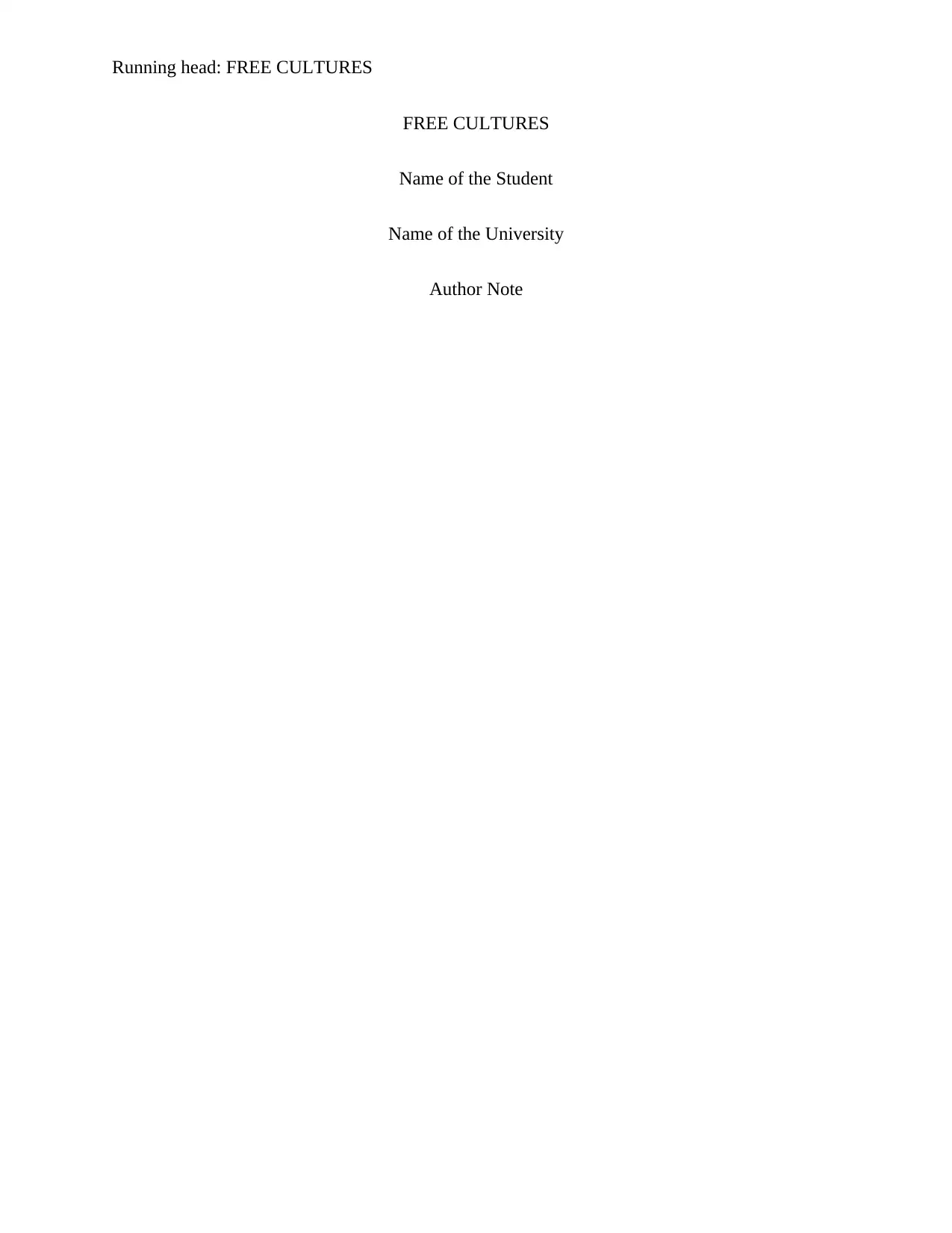
Running head: FREE CULTURES
FREE CULTURES
Name of the Student
Name of the University
Author Note
FREE CULTURES
Name of the Student
Name of the University
Author Note
Paraphrase This Document
Need a fresh take? Get an instant paraphrase of this document with our AI Paraphraser
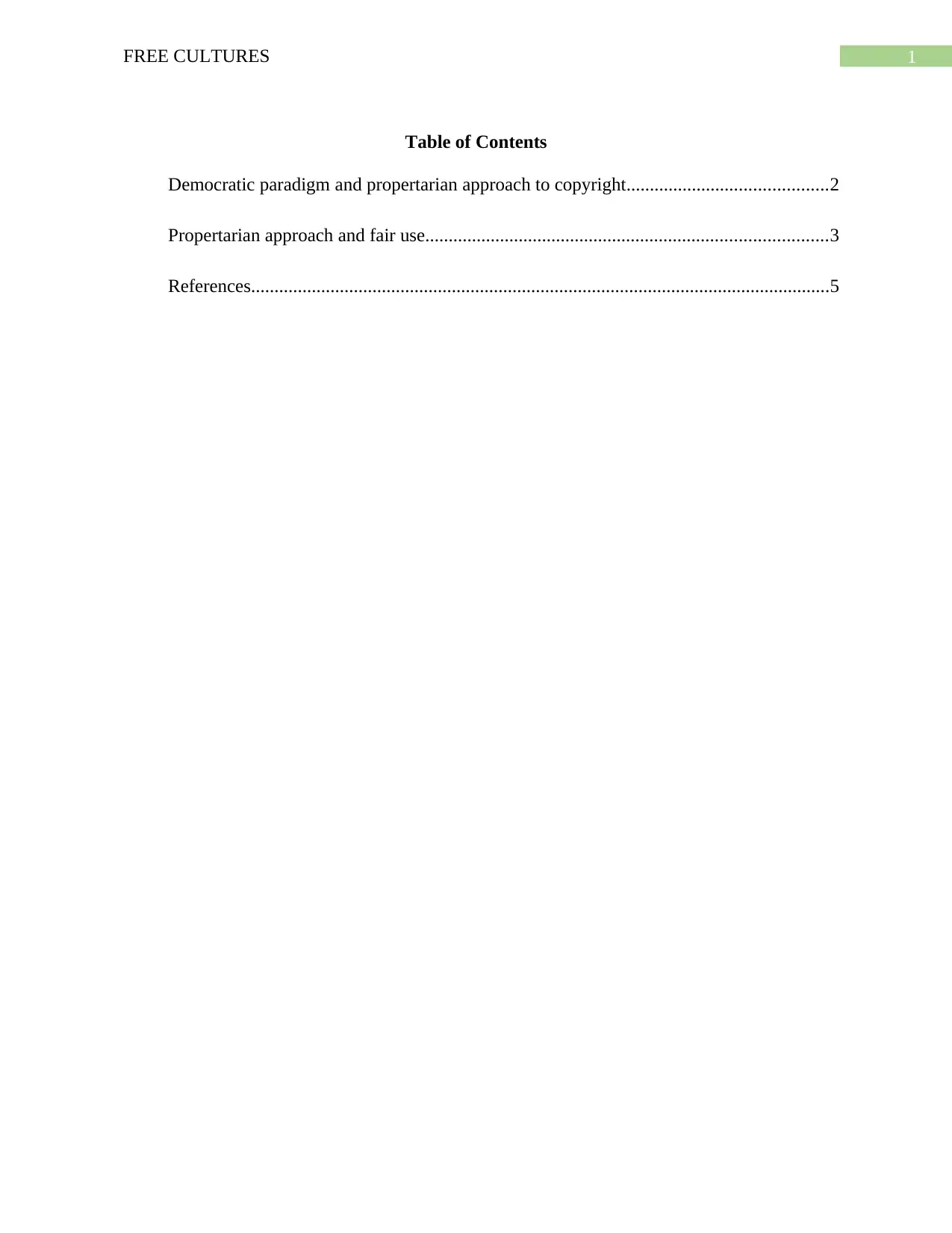
1FREE CULTURES
Table of Contents
Democratic paradigm and propertarian approach to copyright...........................................2
Propertarian approach and fair use......................................................................................3
References............................................................................................................................5
Table of Contents
Democratic paradigm and propertarian approach to copyright...........................................2
Propertarian approach and fair use......................................................................................3
References............................................................................................................................5
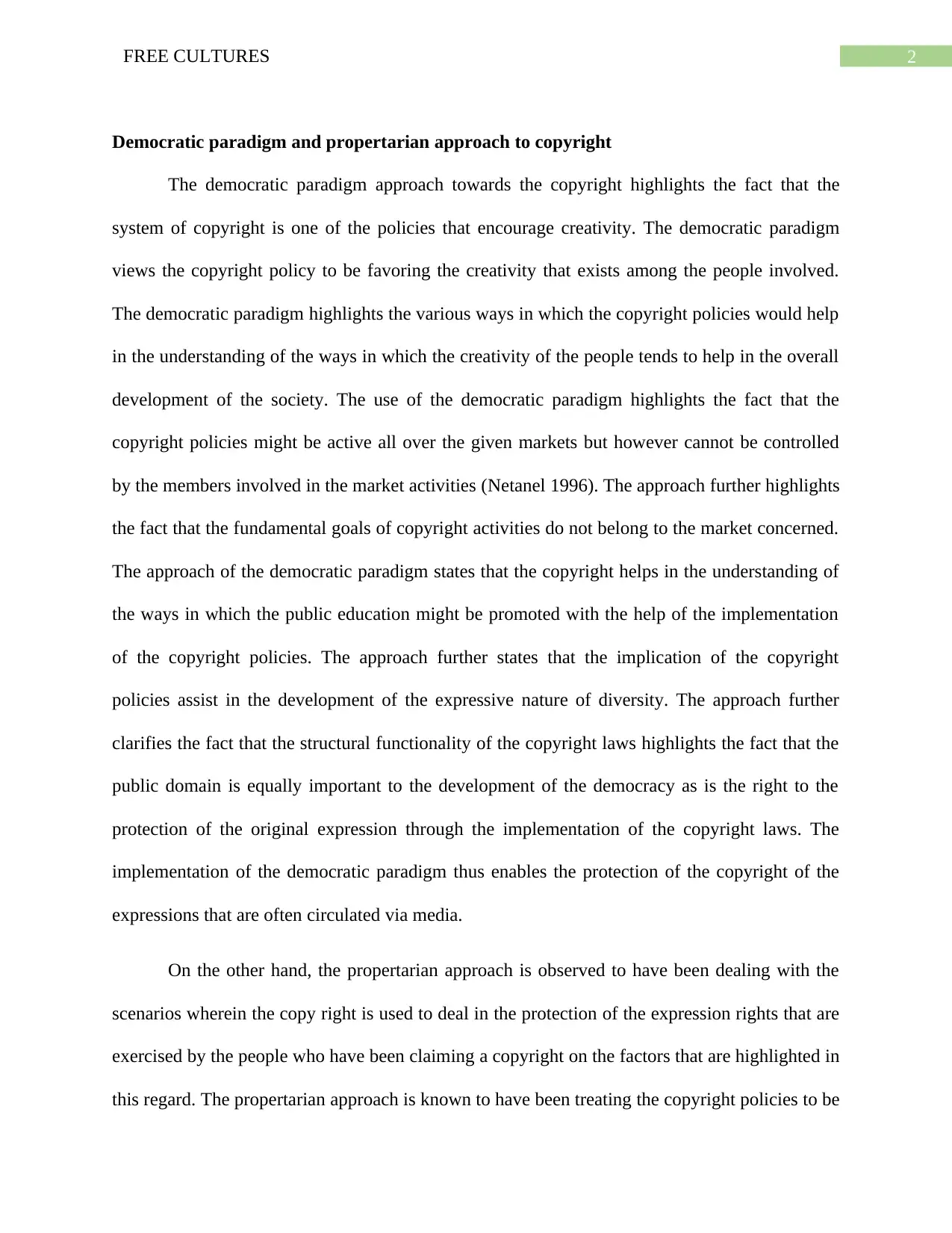
2FREE CULTURES
Democratic paradigm and propertarian approach to copyright
The democratic paradigm approach towards the copyright highlights the fact that the
system of copyright is one of the policies that encourage creativity. The democratic paradigm
views the copyright policy to be favoring the creativity that exists among the people involved.
The democratic paradigm highlights the various ways in which the copyright policies would help
in the understanding of the ways in which the creativity of the people tends to help in the overall
development of the society. The use of the democratic paradigm highlights the fact that the
copyright policies might be active all over the given markets but however cannot be controlled
by the members involved in the market activities (Netanel 1996). The approach further highlights
the fact that the fundamental goals of copyright activities do not belong to the market concerned.
The approach of the democratic paradigm states that the copyright helps in the understanding of
the ways in which the public education might be promoted with the help of the implementation
of the copyright policies. The approach further states that the implication of the copyright
policies assist in the development of the expressive nature of diversity. The approach further
clarifies the fact that the structural functionality of the copyright laws highlights the fact that the
public domain is equally important to the development of the democracy as is the right to the
protection of the original expression through the implementation of the copyright laws. The
implementation of the democratic paradigm thus enables the protection of the copyright of the
expressions that are often circulated via media.
On the other hand, the propertarian approach is observed to have been dealing with the
scenarios wherein the copy right is used to deal in the protection of the expression rights that are
exercised by the people who have been claiming a copyright on the factors that are highlighted in
this regard. The propertarian approach is known to have been treating the copyright policies to be
Democratic paradigm and propertarian approach to copyright
The democratic paradigm approach towards the copyright highlights the fact that the
system of copyright is one of the policies that encourage creativity. The democratic paradigm
views the copyright policy to be favoring the creativity that exists among the people involved.
The democratic paradigm highlights the various ways in which the copyright policies would help
in the understanding of the ways in which the creativity of the people tends to help in the overall
development of the society. The use of the democratic paradigm highlights the fact that the
copyright policies might be active all over the given markets but however cannot be controlled
by the members involved in the market activities (Netanel 1996). The approach further highlights
the fact that the fundamental goals of copyright activities do not belong to the market concerned.
The approach of the democratic paradigm states that the copyright helps in the understanding of
the ways in which the public education might be promoted with the help of the implementation
of the copyright policies. The approach further states that the implication of the copyright
policies assist in the development of the expressive nature of diversity. The approach further
clarifies the fact that the structural functionality of the copyright laws highlights the fact that the
public domain is equally important to the development of the democracy as is the right to the
protection of the original expression through the implementation of the copyright laws. The
implementation of the democratic paradigm thus enables the protection of the copyright of the
expressions that are often circulated via media.
On the other hand, the propertarian approach is observed to have been dealing with the
scenarios wherein the copy right is used to deal in the protection of the expression rights that are
exercised by the people who have been claiming a copyright on the factors that are highlighted in
this regard. The propertarian approach is known to have been treating the copyright policies to be
⊘ This is a preview!⊘
Do you want full access?
Subscribe today to unlock all pages.

Trusted by 1+ million students worldwide
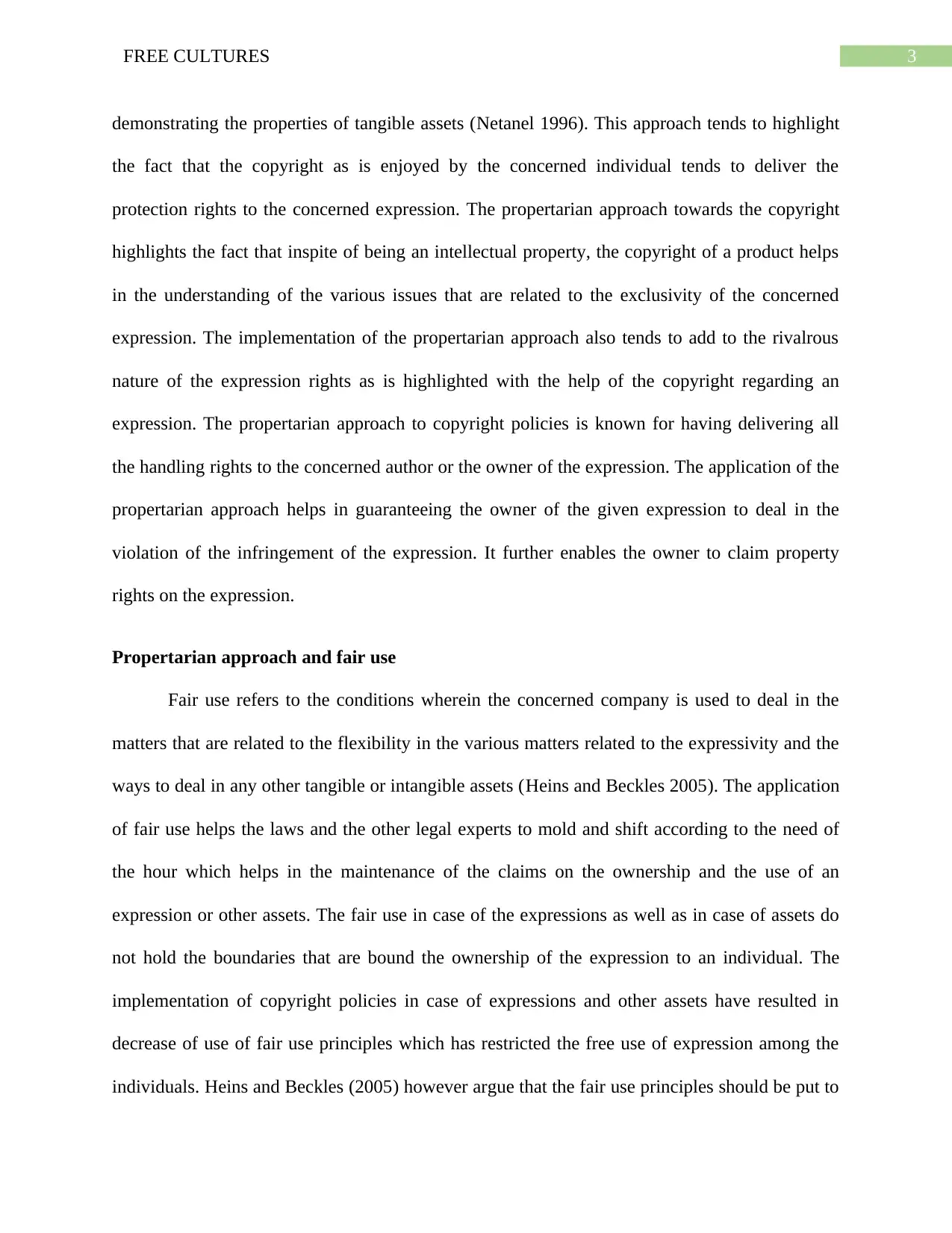
3FREE CULTURES
demonstrating the properties of tangible assets (Netanel 1996). This approach tends to highlight
the fact that the copyright as is enjoyed by the concerned individual tends to deliver the
protection rights to the concerned expression. The propertarian approach towards the copyright
highlights the fact that inspite of being an intellectual property, the copyright of a product helps
in the understanding of the various issues that are related to the exclusivity of the concerned
expression. The implementation of the propertarian approach also tends to add to the rivalrous
nature of the expression rights as is highlighted with the help of the copyright regarding an
expression. The propertarian approach to copyright policies is known for having delivering all
the handling rights to the concerned author or the owner of the expression. The application of the
propertarian approach helps in guaranteeing the owner of the given expression to deal in the
violation of the infringement of the expression. It further enables the owner to claim property
rights on the expression.
Propertarian approach and fair use
Fair use refers to the conditions wherein the concerned company is used to deal in the
matters that are related to the flexibility in the various matters related to the expressivity and the
ways to deal in any other tangible or intangible assets (Heins and Beckles 2005). The application
of fair use helps the laws and the other legal experts to mold and shift according to the need of
the hour which helps in the maintenance of the claims on the ownership and the use of an
expression or other assets. The fair use in case of the expressions as well as in case of assets do
not hold the boundaries that are bound the ownership of the expression to an individual. The
implementation of copyright policies in case of expressions and other assets have resulted in
decrease of use of fair use principles which has restricted the free use of expression among the
individuals. Heins and Beckles (2005) however argue that the fair use principles should be put to
demonstrating the properties of tangible assets (Netanel 1996). This approach tends to highlight
the fact that the copyright as is enjoyed by the concerned individual tends to deliver the
protection rights to the concerned expression. The propertarian approach towards the copyright
highlights the fact that inspite of being an intellectual property, the copyright of a product helps
in the understanding of the various issues that are related to the exclusivity of the concerned
expression. The implementation of the propertarian approach also tends to add to the rivalrous
nature of the expression rights as is highlighted with the help of the copyright regarding an
expression. The propertarian approach to copyright policies is known for having delivering all
the handling rights to the concerned author or the owner of the expression. The application of the
propertarian approach helps in guaranteeing the owner of the given expression to deal in the
violation of the infringement of the expression. It further enables the owner to claim property
rights on the expression.
Propertarian approach and fair use
Fair use refers to the conditions wherein the concerned company is used to deal in the
matters that are related to the flexibility in the various matters related to the expressivity and the
ways to deal in any other tangible or intangible assets (Heins and Beckles 2005). The application
of fair use helps the laws and the other legal experts to mold and shift according to the need of
the hour which helps in the maintenance of the claims on the ownership and the use of an
expression or other assets. The fair use in case of the expressions as well as in case of assets do
not hold the boundaries that are bound the ownership of the expression to an individual. The
implementation of copyright policies in case of expressions and other assets have resulted in
decrease of use of fair use principles which has restricted the free use of expression among the
individuals. Heins and Beckles (2005) however argue that the fair use principles should be put to
Paraphrase This Document
Need a fresh take? Get an instant paraphrase of this document with our AI Paraphraser
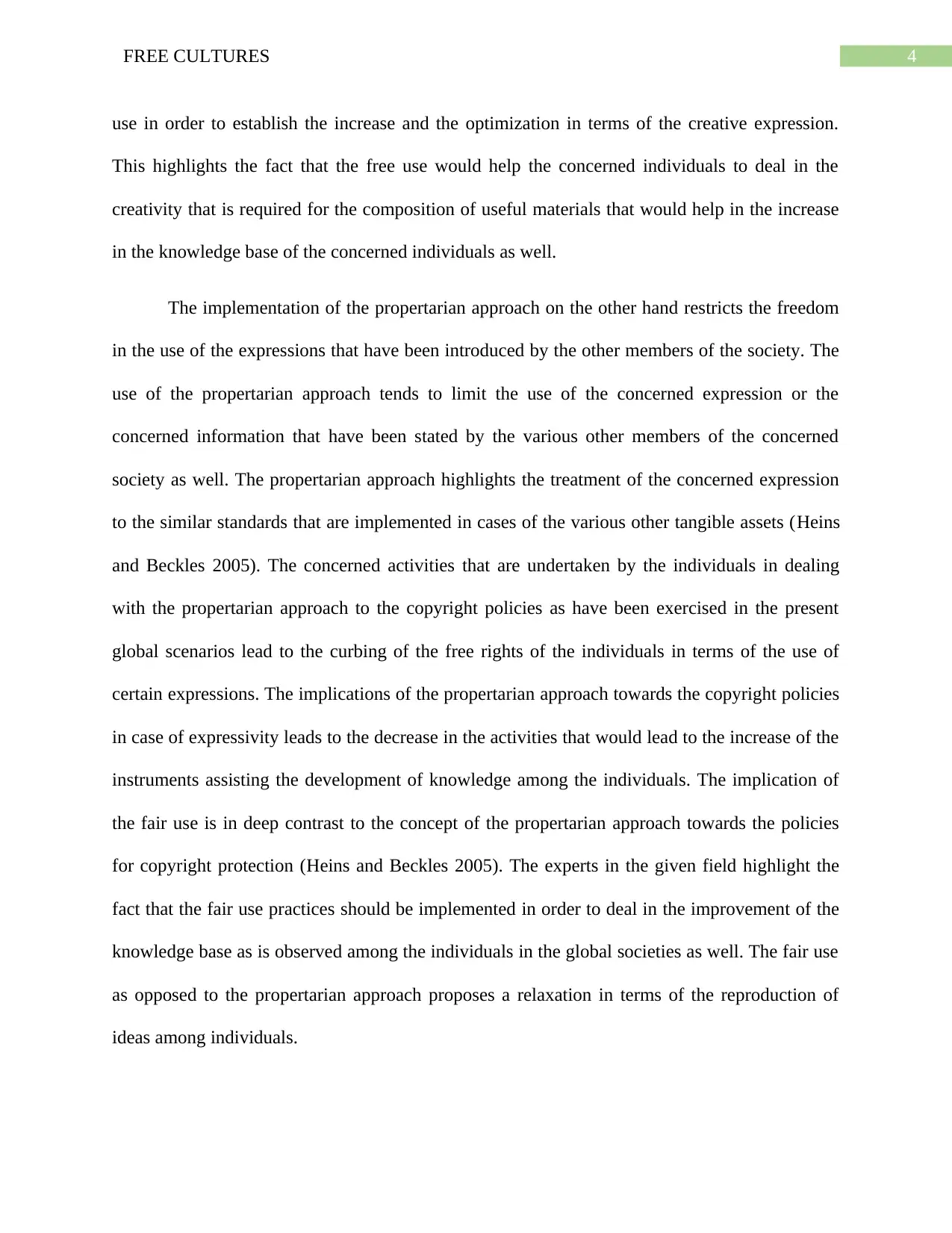
4FREE CULTURES
use in order to establish the increase and the optimization in terms of the creative expression.
This highlights the fact that the free use would help the concerned individuals to deal in the
creativity that is required for the composition of useful materials that would help in the increase
in the knowledge base of the concerned individuals as well.
The implementation of the propertarian approach on the other hand restricts the freedom
in the use of the expressions that have been introduced by the other members of the society. The
use of the propertarian approach tends to limit the use of the concerned expression or the
concerned information that have been stated by the various other members of the concerned
society as well. The propertarian approach highlights the treatment of the concerned expression
to the similar standards that are implemented in cases of the various other tangible assets (Heins
and Beckles 2005). The concerned activities that are undertaken by the individuals in dealing
with the propertarian approach to the copyright policies as have been exercised in the present
global scenarios lead to the curbing of the free rights of the individuals in terms of the use of
certain expressions. The implications of the propertarian approach towards the copyright policies
in case of expressivity leads to the decrease in the activities that would lead to the increase of the
instruments assisting the development of knowledge among the individuals. The implication of
the fair use is in deep contrast to the concept of the propertarian approach towards the policies
for copyright protection (Heins and Beckles 2005). The experts in the given field highlight the
fact that the fair use practices should be implemented in order to deal in the improvement of the
knowledge base as is observed among the individuals in the global societies as well. The fair use
as opposed to the propertarian approach proposes a relaxation in terms of the reproduction of
ideas among individuals.
use in order to establish the increase and the optimization in terms of the creative expression.
This highlights the fact that the free use would help the concerned individuals to deal in the
creativity that is required for the composition of useful materials that would help in the increase
in the knowledge base of the concerned individuals as well.
The implementation of the propertarian approach on the other hand restricts the freedom
in the use of the expressions that have been introduced by the other members of the society. The
use of the propertarian approach tends to limit the use of the concerned expression or the
concerned information that have been stated by the various other members of the concerned
society as well. The propertarian approach highlights the treatment of the concerned expression
to the similar standards that are implemented in cases of the various other tangible assets (Heins
and Beckles 2005). The concerned activities that are undertaken by the individuals in dealing
with the propertarian approach to the copyright policies as have been exercised in the present
global scenarios lead to the curbing of the free rights of the individuals in terms of the use of
certain expressions. The implications of the propertarian approach towards the copyright policies
in case of expressivity leads to the decrease in the activities that would lead to the increase of the
instruments assisting the development of knowledge among the individuals. The implication of
the fair use is in deep contrast to the concept of the propertarian approach towards the policies
for copyright protection (Heins and Beckles 2005). The experts in the given field highlight the
fact that the fair use practices should be implemented in order to deal in the improvement of the
knowledge base as is observed among the individuals in the global societies as well. The fair use
as opposed to the propertarian approach proposes a relaxation in terms of the reproduction of
ideas among individuals.
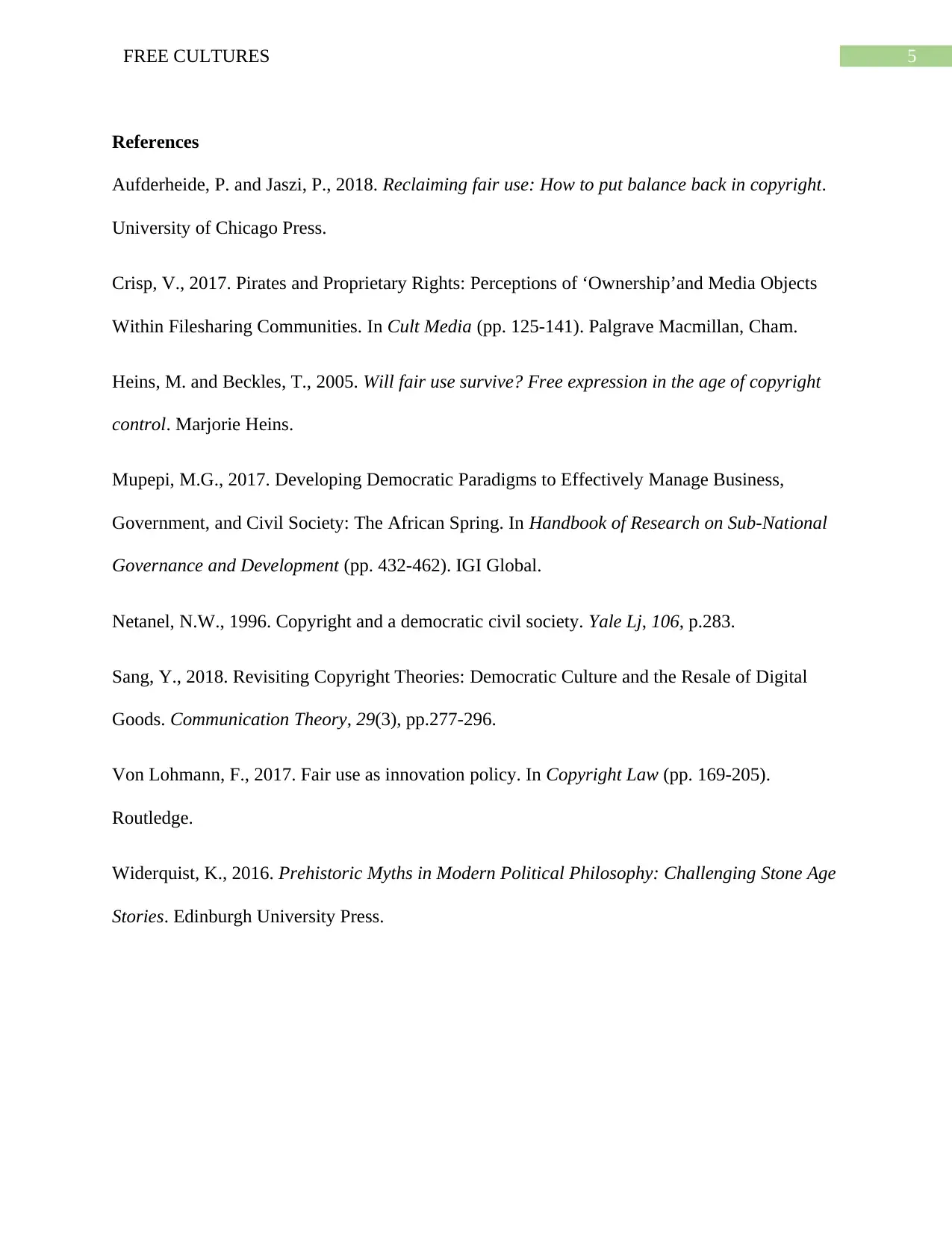
5FREE CULTURES
References
Aufderheide, P. and Jaszi, P., 2018. Reclaiming fair use: How to put balance back in copyright.
University of Chicago Press.
Crisp, V., 2017. Pirates and Proprietary Rights: Perceptions of ‘Ownership’and Media Objects
Within Filesharing Communities. In Cult Media (pp. 125-141). Palgrave Macmillan, Cham.
Heins, M. and Beckles, T., 2005. Will fair use survive? Free expression in the age of copyright
control. Marjorie Heins.
Mupepi, M.G., 2017. Developing Democratic Paradigms to Effectively Manage Business,
Government, and Civil Society: The African Spring. In Handbook of Research on Sub-National
Governance and Development (pp. 432-462). IGI Global.
Netanel, N.W., 1996. Copyright and a democratic civil society. Yale Lj, 106, p.283.
Sang, Y., 2018. Revisiting Copyright Theories: Democratic Culture and the Resale of Digital
Goods. Communication Theory, 29(3), pp.277-296.
Von Lohmann, F., 2017. Fair use as innovation policy. In Copyright Law (pp. 169-205).
Routledge.
Widerquist, K., 2016. Prehistoric Myths in Modern Political Philosophy: Challenging Stone Age
Stories. Edinburgh University Press.
References
Aufderheide, P. and Jaszi, P., 2018. Reclaiming fair use: How to put balance back in copyright.
University of Chicago Press.
Crisp, V., 2017. Pirates and Proprietary Rights: Perceptions of ‘Ownership’and Media Objects
Within Filesharing Communities. In Cult Media (pp. 125-141). Palgrave Macmillan, Cham.
Heins, M. and Beckles, T., 2005. Will fair use survive? Free expression in the age of copyright
control. Marjorie Heins.
Mupepi, M.G., 2017. Developing Democratic Paradigms to Effectively Manage Business,
Government, and Civil Society: The African Spring. In Handbook of Research on Sub-National
Governance and Development (pp. 432-462). IGI Global.
Netanel, N.W., 1996. Copyright and a democratic civil society. Yale Lj, 106, p.283.
Sang, Y., 2018. Revisiting Copyright Theories: Democratic Culture and the Resale of Digital
Goods. Communication Theory, 29(3), pp.277-296.
Von Lohmann, F., 2017. Fair use as innovation policy. In Copyright Law (pp. 169-205).
Routledge.
Widerquist, K., 2016. Prehistoric Myths in Modern Political Philosophy: Challenging Stone Age
Stories. Edinburgh University Press.
⊘ This is a preview!⊘
Do you want full access?
Subscribe today to unlock all pages.

Trusted by 1+ million students worldwide
1 out of 6
Related Documents
Your All-in-One AI-Powered Toolkit for Academic Success.
+13062052269
info@desklib.com
Available 24*7 on WhatsApp / Email
![[object Object]](/_next/static/media/star-bottom.7253800d.svg)
Unlock your academic potential
Copyright © 2020–2025 A2Z Services. All Rights Reserved. Developed and managed by ZUCOL.





